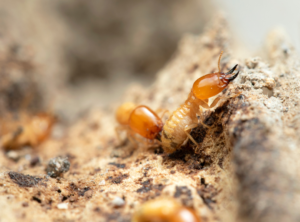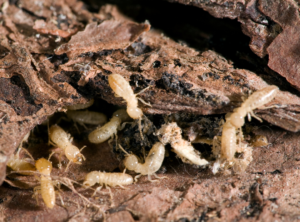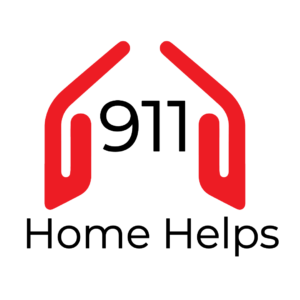Termites are fascinating insects belonging to the order Blattodea, which also includes cockroaches. Often referred to as “silent destroyers,” they are known for their ability to consume wood, paper, and other cellulose-based materials, which can lead to significant structural damage in homes and buildings. Here are key points about termites:

1. Social Structure: Termites are social insects, living in colonies that can range from a few hundred to millions of individuals. Their colonies have a complex social structure, consisting of different castes:
– Workers: These are the non-reproductive members responsible for foraging, feeding, building, and maintaining the nest. They are typically blind and emerge in large numbers to gather food.
– Soldiers: Larger than workers, soldiers protect the colony from predators, primarily ants. They possess strong jaws for defense but do not participate in foraging.
– Reproductives: This caste includes the queen and king. The queen is prolific, laying thousands of eggs daily, while the king supports her during reproduction and is often by her side throughout their lives.
2. Types of Termites:
– Subterranean Termites: These termites live underground and are the most common type found in the U.S. They construct mud tubes to access food sources while staying protected from moisture loss and predators.
– Drywood Termites: Found primarily in warm, dry climates, they infest dry wood and do not require contact with the soil. They get moisture from the wood they consume and often create visible exit holes.
– Dampwood Termites: These prefer decaying or damp wood and are usually found in areas with high moisture, such as rotting trees or fallen logs.
3. Diet and Digestion: Termites primarily feed on cellulose, found in wood, leaves, and other plant materials. They have gut microorganisms (protozoa and bacteria) that help them digest cellulose, allowing them to break down materials that many other organisms cannot.
4. Ecological Role: While termites are considered pests when they invade structures, they play a crucial role in the ecosystem by breaking down dead and decaying organic matter. This process enriches the soil and promotes nutrient cycling.
5. Signs of Infestation: Common signs that termites are present in or around a structure include:
– Mud tubes on walls or foundations.
– Swarmers (winged termites) emerging from the ground or wood.
– Hollow-sounding wood or visible wood damage.
– Discarded wings near entry points or on windowsills.
6. Prevention and Treatment: It is essential to implement prevention measures, such as maintaining a dry environment, sealing cracks, and conducting regular inspections. If an infestation occurs, various treatment options are available, including liquid pesticides, baiting systems, and professional extermination services.
Understanding termites’ behavior, types, and ecological significance can help homeowners and property managers take proactive steps in managing the risk of infestation.

In Florida, termite swarm season is characterized by specific patterns due to the humid subtropical climate. Here are the key details regarding termite swarm season in Florida:
1. Timing: Termite swarming in Florida generally occurs from March to November, with the peak months being April, May, and June. However, swarming can occur at any time during warm, humid weather.
2. Species: Florida is home to several termite species, most notably:
– Subterranean Termites: These are the most common and typically swarm in the spring, especially after rain when the humidity is high.
– Drywood Termites: Swarming may be more prevalent in late summer through early fall, often during the warmer months when humidity increases.
3. Temperature and Humidity: Swarm activity is triggered when temperatures reach approximately 70°F (21°C) and humidity levels are high. Rainy days can also prompt swarms as termites take advantage of favorable conditions for establishing new colonies.
4. Signs of Swarming: Homeowners should be vigilant for the following during swarm season:
– Swarmers (winged reproductive termites) emerging from colonies, typically at dusk.
– Discarded wings found in and around windowsills or light sources.
– Mud tubes and visible damage on wood structures.
5. Local Variation: Due to Florida’s diverse ecosystems, the timing and frequency of swarms may vary depending on the specific region within the state—for example, swarming might occur earlier in southern Florida compared to northern counties.
6. Pre-emptive Measures: Homeowners in Florida should take proactive steps during swarm season:
– Conduct regular inspections for signs of termite activity.
– Maintain dry and well-drained areas around the foundation to reduce humidity.
– Ensure proper sealing of entry points to prevent swarmer infestations.
Understanding these seasonal patterns and regional variations will help Florida homeowners manage and protect their properties from potential termite threats effectively.

Here are some unique and creative “termite tips” that can help homeowners prevent, identify, and deal with termite issues effectively:
1. Build a Barrier: Create a physical barrier using steel mesh or gravel around your home’s foundation. This can deter termite entry and disrupt their tunneling.
2. Moisture Control: Termites thrive in moist environments. Ensure proper drainage around your home, repair leaky pipes, and use dehumidifiers in damp areas to reduce humidity.
3. Natural Deterrents: Consider using natural deterrents like cedar mulch or nematodes (tiny worms) that actively prey on termites. These eco-friendly options can help keep termites at bay.
4. Routine Inspections: Schedule annual inspections with a pest control professional. Inspections can uncover early signs of termite activity before they cause significant damage.
5. DIY Termite Baiting: Create homemade bait stations using cardboard or untreated wood to monitor termite activity. Place these baits in areas where you suspect termites and check for signs of feeding.
6. Seal Entry Points: Inspect and seal cracks and gaps around windows, doors, and the foundation. This not only helps prevent termite entry but also improves your home’s energy efficiency.
7. Landscaping Awareness: Keep wood mulch at least 15 inches away from your foundation and avoid planting trees or shrubs with root systems close to your home, as they can provide easy access points for termites.
8. Educate Yourself: Familiarize yourself with termite species prevalent in your area. Different species may require different treatment approaches, so understanding their behavior can be crucial.
9. Insecticidal Soils: If you live in a high-risk area, consider treating your soil with an insecticide before building. This creates a long-lasting barrier against termites.
10. Caution with Firewood: Store firewood at least 20 feet away from your home and elevate it off the ground. This helps prevent termites from accessing it and migrating to your house.
11. Fumigation Knowledge: Understand when fumigation is necessary and be aware of alternative treatment methods. If your home shows heavy infestation signs, consult professionals about the best approach.
12. Watch for Warning Signs: Stay vigilant for termite signs such as mud tubes, discarded wings, or hollow-sounding wood. Early detection can lead to simpler and less expensive treatments.
13. Termite Insurance Add-Ons: Check your homeowner’s insurance policy. Some insurance providers offer termite damage coverage as an add-on, which can be beneficial in case of an infestation.
14. Community Awareness: Share knowledge with neighbors about termite prevention in your area. A united front in termite awareness can lead to better detection and treatment efforts locally.
15. Earth-Friendly Options: Explore eco-friendly pest control options, such as orange oil or borate treatments, which can be effective against termites and less harmful to the environment.
These tips can help homeowners proactively manage potential termite issues and keep their homes safe from these destructive pests.
For more information from a Licensed Termite Inspection & Treatment company visit:
911 Home Helps
A family-run business with more than 10 years of experience offering the best pest control and treatments. Visit their home site below:

